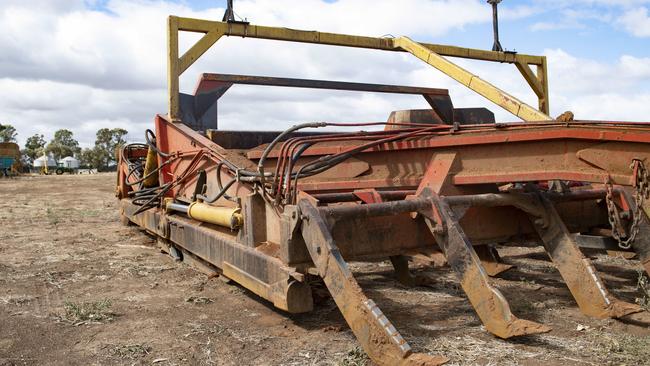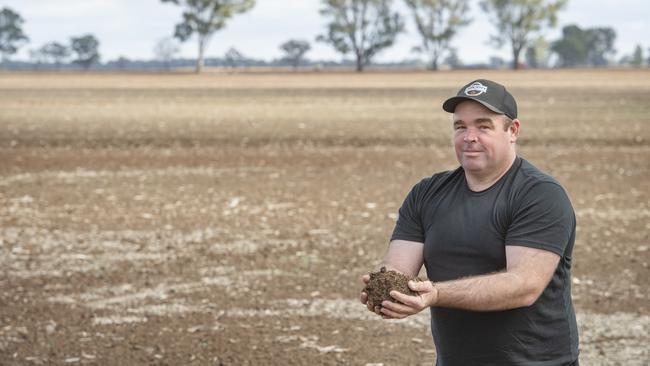Pushing the margins in irrigated cropping operation
Mark and Kendall van Beek in the southern Riverina have one eye on the future as they strive to perfect management techniques that will allow for expansion.

Focusing on crop yields and efficiency in an irrigated operation in the southern Riverina is paying dividends for one farming family.
Mark van Beek farms 755ha with his wife Kendall and their two children, Freya, 2, and Eden, 6 months.
They strive to tweak and perfect management techniques that will allow for expansion as they move towards incorporating summer crops into the mix next year.
Located at Pine Lodge, near the southern border region of NSW, they currently run a winter cropping operation. Eighty per cent of the land is under irrigation, and this complements the average annual rainfall of 430mm.
Mark, 36, bought his first farm at 20 and gained his passion for agriculture and adopted a keen work ethic after growing up on the family dairy farm.
Now, he grows wheat and canola under irrigation as winter crops, and plans are underway to expand into corn and cotton in a summer cropping program. The family also plans to sow around 45ha of irrigated lucerne within the next three months.
The dryland country will ultimately be developed for irrigation, too. However, it has been used for opportunity farming, such as trading livestock when the market is favourable.
Mark said laser levelling and developments to move the farm towards further overall automation are essential in helping to reach their goals on the land, which features red-loam soil.
EVERY DROP COUNTS
“We are trying to get efficiencies out of the land and the water,” he said.
The farm is on the Murray Irrigation system, and there is also some supplementary watering from bores.
The political uncertainty regarding the Murray Darling Rivers and water buybacks meant an element of self-sufficiency was important.
Meanwhile, Mark has embraced GPS guidance technology on the machinery he uses and is grateful for backup advice from an agronomist with regular soil testing too to help accurately determine what inputs are needed.
For the past two years they have been using manure from his parent’s piggery, located 45 kilometres away.
“We have been composting the manure from the piggery and putting it on the paddocks,” he said.
The compost is applied using a spreader at 10 tonnes/ha.
Lime and gypsum are also essential inputs, implied at rates determined by soil testing. The mix is generally one tonne/ha of gypsum and two tonnes/ha of lime.
“We soil test and have the philosophy of what gets measured gets managed,” he said.
“We should see a marked improvement not only in the mineral base but also in soil structure,” he said.

PRODUCTIVE SOIL
“We wouldn’t call ourselves organic, but we are conscious of the environment and try to do the best for the environment,” he said.
A combination of fertile soils and irrigation assists in some handy results for the irrigated winter crops.
“With our wheat, we always aim for high protein because there are premiums to be had,” Mark said.
He has been selecting rust-tolerant hard wheat varieties and the straw from the crop is later baled after harvest and can be incorporated back into the piggery for bedding.
“We aim to do the full circle,” he said.
The canola crops have produced 42 per cent oil and there are plans to try and push that higher through measurement and agronomy.
“We can improve this over time,” he said.
After pre-watering, canola crops will be planted during the second week of April. The wheat will follow in mid-April.
Later at harvest the canola is direct headed at harvest, rather than using the traditional windrowing method.
“It is a little bit different, but we do this because it is a cost-saving measure,” he said.
“The machinery is getting bigger and bigger and more expensive,” he said.
Direct heading reduces the number of passes on a paddock and is also beneficial in terms of the amount of time it takes.
“We are able to harvest the canola in a timely fashion without being hindered … we have been doing this for about 10 years, and it is becoming more common,” he said.
The operation is backed up by some casual workers during the busy periods at sowing and harvest.

CONTROLLED-TRAFFIC EFFICIENCY
Crops are direct drilled using an Australian-made Ausplow Air seeder and a 12-metre controlled-traffic-farming configuration is used.
“We use three-metre wheel spacing where we can,” he said.
Controlled traffic farming methods have helped reduce soil compaction.
Canola is sown at a rate of 3.6kg/ha and wheat at 80kg/ha to 120kg/ha.
The rotation consists of two years of wheat crop production followed by one of canola production, and this has occurred since 2021. Before being laser-levelled and prepared for irrigated winter cropping, the property supported a dairy-farming operation.
In terms of marketing, there is a plan to spread risk. However, during harvest last year most of the wheat and canola was sold directly to the depot at Tocumwal.

MEETING THE MARKET
With prices for wheat and canola values dropping since harvest, the decision to sell at harvest has proven to be a good one.
“I am pretty thankful that I have sold everything,” he said.
Mark said running a successful farming businesses could be stressful and production costs were rising, which ultimately affected margins.
However, Riverina farmers were on a pinnacle for producing some of the finest quality wheat, fibre, milk, meat and fodder.
He has his sights on planting cotton and corn next year, and he said cotton growing was gradually moving further south.
“We are currently doing land-forming and grading the paddocks and fixing drains so we can handle summer cropping,” he said.
During the initial stages, the cotton will be planted and picked by contractors to negate the need to purchase additional machinery.




